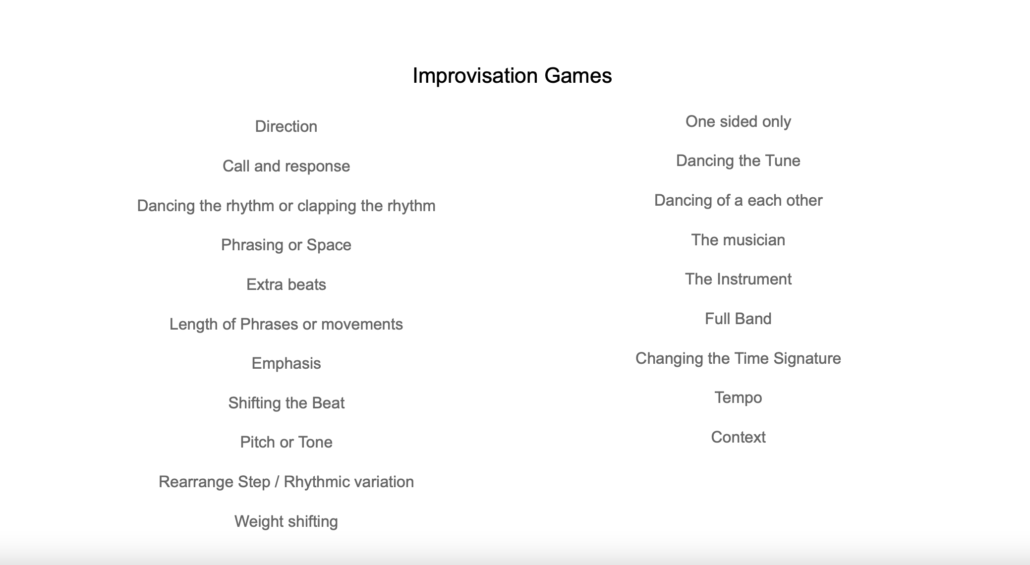intro
week 1
Beginner
- 123’s
- side step
Intermediate
- Double time
- shuff-le backs
- hips
Advanced
- Double time
- shuff-le backs wiht single time
- hips with single time
week 2
Beginner
- Chose any or all steps from last term and dance it to a polka.
- Explore Roisin’s jig steps.
- Abolute begginners class or vocabulary steps and try them to polkas. Search this on the site.
- Beginner Jig course
Intermediate
- Chose any or all steps from last term and dance it to a polka.
- Chose any reel, jig or slide step and dancing it to a polka. Jigs and slides replace the 1234 sound with a reel rhythm or a 123 sound ilke the 123 step from week 1.
Advanced
week 3
week 4
Dancing the Tune!
Biddy Martin’s
Playlist for kid’s class with polka songs and steps
week 5
Improvisation!
There is no right or wrong here today. Improvisation is about play and playing with your steps and the music. Mistakes are not mistakes, keep going and exploring.

- Full variation & creation list document – This is a google document. You can view it and if you want a copy or want to edit it save it to your google drive and you will be able to do anything you like to the document.
- Variations & creation list
- 28 | Tea Time Talk | Improvisation
week 6
Step Creation!
Beginner
- 123’s – insert a movement
Intermediate
- Advance & Retire step – insert a movement
Advanced
- Double time reel step (shit step) – insert a movement
Insert a movement – insert a movement or a pattern into the original step. You might have to remove an equal amount of bars to make the step square or you can choose to leave them in and have a step that goes across the bars of music or something that you square off eventually.
- Insert: the Swung side step
- Insert: one of the reel steps from Spring term.
- Direction: Create something that works for moving in a leadaround pattern.
- Play with another direction.
- Rearrange the Step: Move the parts of the step around to create a new pattern.
- Rearrange the rhythm – rearrange the step to create a different rhythm.
Full variation & creation list document
week 7
Putting it all together!
Beginner
Intermediate
Advanced
Set Dance steps – Mapped, Half Mapped and Unmapped
You can also apply all of what we have learned over the last 6 weeks to your set dancing. Here’s the Cashel set if you would like to apply this to your set dancing.
Cashel Set – You could map what advance & retire step you might use for the Cashel set. There are other polka sets as well that you could do this with.
Mapped out
Here are a few mapped out options for you to explore.
Roisin Steps to Polkas – Mapped out
- Stamp & Stamp
- Heel & Stab
- Cross Step
- Circle Step
- Zig Zag
- Side Step (3)
- Single Side step
- Heel Toe Heel
Polka steps – Mapped out
- 123’s (with or without heel or tap extra beats)
- 1 & 2 & 123 (with or without heel or tap extra beats)
- Side step (with or without heel or tap extra beats)
- Mick’s Advance & Retire Step
- Kick Up step
- Any trick in polka time with 123’s as the timming step
Half Mapped
Alternate between happed and unmapped. Chose one step to keep going back to or map out a routine and leave everyother 8 bars open.
Unmapped
Unmapped. You can take everything you have learned and dance unmapped. Your steps can be unmapped but if you want some guide rails try picking a few improvisational tricks and dance with them in mind. In class we only danced one at a time as an exercise. The skys the limit. Pick as few or as many as you want to play with. Full variation & creation list document
week 8
Putting it all together!
Beginner
Intermediate
Advanced
Continue to work on your routines mapped or unmapped.
tunes
Music page – Membership music page. Here you will find many of the tunes on this site in one place. Each tune has a page with resources and downloads. Some tunes have a breakdown of the tune in a spreadsheet that you can use for writing and mapping out steps. If there is a tune that is not done yet and you would like to use it please let me know and I will create a breakdown for you. Over time my hope is to have a breakdown for each tune on the site to make it easy for you to create routines and choreography.
Here are a few tunes to get you started.
